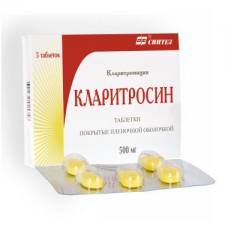Expiration date: 11/2026
The composition and form of issue:
Tablets, film-coated. 1 tablet contains:
clarithromycin 250 or 500 mg
other ingredients: microcrystalline cellulose PVP (povidone) milk sugar (lactose) starch potato silica colloidal anhydrous (Aerosil) magnesium stearate talc
shell: oksipropilmetiltselljuloza (polymer) titanium dioxide polyethylene oxide 4000 (polyethylene glycol 4000) tropeolin About
in the package contour 5 or 10 pieces in a cardboard unit 1 or 2 packaging or in a polymeric 10 or 20 PCs the paper cartons 1 Bank.
Description of dosage form:
250 mg tablets: round biconvex, covered with a yellow film coating.
Tablets of 500 mg: oval, covered with a film cover of yellow color.
Pharmacokinetics:
Absorption-fast. Food slows down absorption without significantly affecting bioavailability. Communication with plasma proteins - more than 90%. After a single reception, two Cmax peaks are logged. The second peak is due to the ability of the drug to concentrate in the gallbladder, followed by gradual or rapid release. The time to reach Cmax after oral administration of 250 mg — 1-3 hours
After oral administration, 20% of the dose quickly hydroxylated liver cytochrome P450 enzymes to form the main metabolite — 14-hydroxyclarithromycin, which has a pronounced antimicrobial activity against Haemophilus influenzae.
With regular intake of 250 mg / day, the equilibrium concentration of the unchanged drug and its main metabolite — 1 and 0, 6 µg/ml, respectively T1/2 — 3-4 h and 5-6 h, respectively. When increasing the dose to 500 mg / day, the equilibrium concentration of the unchanged drug and its metabolite in plasma — 2, 7-2, 9 and 0, 83-0, 88 µg/ml, respectively T1/2 — 4, 8-5 h and 6, 9-8, 7 h, respectively. In therapeutic concentrations accumulates in the lungs, skin and soft tissues (concentration in them is 10 times higher than the level in serum).
It is excreted by the kidneys and with feces (20-30% — unchanged, the rest — in the form of metabolites). With a single dose of 250 mg and 1, 2 g of kidneys is 37, 9 and 46%, with feces - 40, 2 and 29, 1%, respectively.
Description of the pharmacological action:
Bacteriostatic macrolide antibiotic of the II generation broad-spectrum. Violates the protein synthesis of microorganisms (binds with 50S subunit of ribosome membrane of microbial cells).
Active against Streptococcus agalactiae, Streptococcus pyogenes, Streptococcus viridans, Streptococcus pneumoniae, Haemophilus influenzae (parainfluenzae), Haemophilus ducreyi, Neisseria gonorrhoeae, Neisseria meningitidis, Listeria monocytogenes, Legionella pneumophila, Mycoplasma pneumoniae, Helicobacter (Campylobacter) pylori, Campylobacter jejuni, Chlamydia pneumoniae (trachomatis), Moraxella (Branhamella) catarrhalis, Bordetella pertussis, Propionibacterium acnes, Mycobacterium avium, Mycobacterium leprae, Staphylococcus aureus, Ureaplasma urealyticum, Toxoplasma gondii, Corynebacterium spp., Borrelia burgdorferi, Pasteurella multocida, some anaerobes (Eubacterium spp., Peptococcus spp., Propionibacterium spp., Clostridium perfringens, Bacteroides melaninogenicus) and all mycobacteria except M. tuberculosis.
Indications:
Treatment of infectious diseases caused by sensitive microorganisms:
- infections of the lower respiratory tract (bronchitis, pneumonia)
- upper respiratory tract infections (pharyngitis, sinusitis), otitis
- infections of the skin and soft tissues (folliculitis, erysipelas)
- common or localized mycobacterial infections caused by Mycobacterium avium and Mycobacterium intracellulare
- localized infections caused by Mycobacterium chelonae, Mycobacterium fortuitum and Mycobacterium kansasii
- clarithromycin is indicated to eliminate H. pylori and reduce the incidence of duodenal ulcer recurrence.
Contraindications:
Hypersensitivity to antibiotics from the group of macrolides.
Simultaneous use of ergot derivatives, the use of cisapride, pimozide, astemizole and terfenadine (see also "Interactions"). In patients taking these drugs simultaneously with clarithromycin, there is an increase in their concentration in the blood. With the possible prolongation of the QT interval and the development of cardiac arrhythmias, including paroxysmal ventricular tachycardia, ventricular fibrillation and flutter or fibrillation of the ventricles.
Severe violations of the liver and/or kidneys.
Application during pregnancy and breast-feeding:
The use of the drug during pregnancy and lactation is possible only in case when expected benefit for mother exceeds the potential risk to the fetus.
Clarithromycin is excreted in breast milk, so if necessary, the appointment of the drug during lactation should stop breastfeeding.
Side effect:
Most often there are complaints from the gastrointestinal tract (nausea, dyspepsia, abdominal pain, vomiting and diarrhea) there are reports of the development of pseudomembranous colitis from the middle to life-threatening.
Other adverse reactions include transient effects on the Central nervous system — dizziness, anxiety, fear, insomnia, nightmares, tinnitus, confusion, hallucinations, psychosis and depersonalization, headache, taste disorders, hearing loss (which in most cases was restored after discontinuation of the drug) glossitis, stomatitis, candidiasis of the oral mucosa, changes in the color of the tongue and teeth, transient increase in liver enzyme activity, allergic reactions, the intensity of which varies from urticaria and skin rashes, to anaphylaxis and Stevens-Johnson syndrome.
In rare cases-paresthesia, hepatitis with an increase in the level of liver enzymes in the blood and the development of cholestasis and jaundice (liver damage in some cases were severe and, as a rule, reversible in exceptional cases, liver failure with a fatal outcome was observed), an increase in the concentration of creatinine in serum, the development of interstitial nephritis, renal failure hypoglycemia (in some of these cases hypoglycemia developed in patients taking during treatment with clarycemic agents for oral administration or insulin) thrombocytopenia and leukopenia.
In the treatment of clarithromycin, as with other macrolides, very rarely observed elongation of THE Qt interval, ventricular arrhythmia, including ventricular paroxysmal tachycardia and trembling or flickering of the ventricles.
Drug interaction:
While receiving clarithromycin increases the blood concentration of drugs metabolized in the liver by enzymes of the cytochrome P450, indirect anticoagulants, carbamazepine, theophylline, astemizola, cisapride, of terfenadine (2-3 times), triazolama, midazolam, cyclosporine, disopyramide, phenytoin, rifabutin, lovastatin, digoxin, ergot alkaloids etc.
Rare cases of acute necrosis of skeletal muscles, coinciding in time with the simultaneous administration of clarithromycin and inhibitors of HMG-COA reductase-lovastatin and simvastatin are reported.
There are reports of an increase in the concentration of digoxin in plasma in patients receiving both digoxin and clarithromycin tablets. In such patients, it is necessary to constantly monitor the content of digoxin in the serum to avoid digitalis intoxication.
Clarithromycin can reduce the clearance of triazolam and so to increase its pharmacological effects with the development of drowsiness and confusion of consciousness.
The simultaneous use of clarithromycin and ergotamine (ergot derived) can lead to acute ergotamine intoxication, manifested by severe peripheral vasospasm and perverted sensibility.
Co-administration to HIV-infected adults, zidovudine tablets and oral clarithromycin may lead to decrease of equilibrium concentration of zidovudine. Given that clarithromycin is likely to alter the absorption of simultaneously prescribed oral zidovudine, this interaction is largely avoided when taking clarithromycin and zidovudine at different times of the day (at intervals of at least 4 hours).
When concomitant administration of clarithromycin and ritonavir increases the values of serum concentrations of clarithromycin. Correction dose clarithromycin in these cases for patients with normal renal function is not required. However, in patients with creatinine Cl 30 to 60 ml/min the dose of clarithromycin should be reduced by 50%. When Cl creatinine less than 30 ml/min the dose of clarithromycin should be reduced by 75%. While treatment with ritonavir should not be administered clarithromycin at doses above 1 g/day.
Method of application and doses:
Inside, adults the average dose is 250 mg 2 times a day. If necessary, you can appoint 500 mg 2 times a day. The duration of treatment is 6-14 days.
Children drug administered at a dose of 7, 5 mg/kg / day. The maximum daily dose is 500 mg. The duration of treatment is 7-10 days.
For the treatment of infections caused by Mycobacterium avium-1 g 2 times a day. The duration of treatment can be 6 months or more.
In patients with renal insufficiency (CL creatinine less than 30 ml/min) dose should be reduced by 2 times. The maximum duration of the course in patients of this group should be no more than 14 days.
Overdose:
Symptoms: from the digestive tract — nausea, vomiting, diarrhea headache, confusion.
Treatment: immediate gastric lavage and symptomatic treatment. Hemodialysis and peritoneal dialysis do not lead to a significant change in serum clarithromycin levels.
Special instruction:
In the presence of chronic liver diseases, it is necessary to conduct regular monitoring of serum enzymes.
With caution, prescribed against drugs metabolized by the liver (it is recommended to measure their concentration in the blood).
In the case of a joint appointment with warfarin or other indirect anticoagulants must be controlled PV.
Cardiac history is not recommended simultaneous reception of with terfenadine, cisapride, astemizole.
Attention should be paid to the possibility of cross-resistance between clarithromycin and other antibiotics from the macrolide group, as well as lincomycin and clindamycin.
With prolonged or repeated use of the drug may develop superinfection (growth of insensitive bacteria and fungi).


